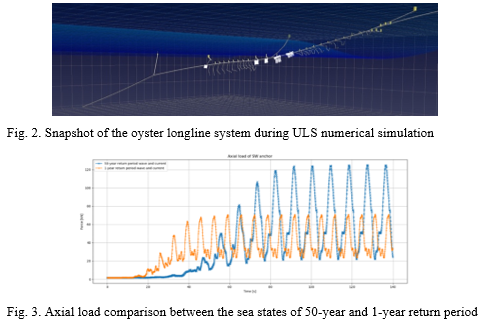OYSTER LONGLINE DESIGN OPTIMIZATION: AQUACULTURE PILOT STUDY IN THE BELGIAN PART OF THE NORTH SEA
Introduction
As part of the European Horizon 2020 project UNITED (UNITED, 2021) , an offshore longline system (Morse and Rice, 2010 ) will be installed to assess the feasibility of cultivating European flat oysters (Ostrea edulis) in the Belgian part of the North Sea 25 n autical miles off shore . Five different culture systems are studied : SEAPA baskets stacked on a ladder frame ; oysters glued on dropper lines ; frames consisting of horizontal and vertical grow-out sticks ; frames as spat collectors ; trays on dropper lines. To accommodate these culture systems, a mooring configuration suitable for the harsh offshore environment is designed. The main cultivation line is 57 m long, making up the total length of 263 m of mooring and backbone ropes from South-West screw anchor to the North-East screw anchor. The distance between both anchors is 250 m. The water depth at the test location is at -30.1 m Mean Lower Low Water Spring.
Materials and methods
A set of boundary conditions are defined based on the operational limitations, space available and guidelines’ recommendations. Fig.1 shows the flowchart of the mooring design iterative process. T he longline system will be installed with anchors within a zone of four wind turbines. Taking this into account , during the operational conditions, the area taken by the mooring system has to be less than 0.12 km2. This governs the longline design characteristics as initial input. Then , a hydro static calculation is performed to ensure that the cultivation line can be lifted 5 m above still water level and the lifting capacity of the vessel is adequate to perform maintenance/installation operations . Lastly , dynamic simulations incorporating waves and current induced load are performed for various scenarios to determine the material properties of the mooring components. Numerical simulations are performed utilising an in-house mooring dynamic solver based on the lumped-mass approach to discretize the lines (Hall and Goupee, 2015; Pribadi et.al, 2019) and the Morison Equation (Morison, 1950) to model the hydrodynamic forces. The Morison coefficients are taken from the guidelines set in the DNV GL OS301 (DNVGL, 2018 ). The sea states used for the U ltimate L imit States (ULS) calculation and safety factors for the line elements are taken from the recommendations provided in the NS9415 document (Norwegian Standard, 2010 ).
Results
The ULS simulation that is taking the 50-year return period of waves () and current ( parallel to the longline, is giving the maximum predicted tension of 125 kN on the mooring lines. The state of the mooring system during the ULS simulation at = 63.8 s is shown in Fig. 2. A maximum load of 71 kN is calculated for the 1-year return period of waves () and current parallel ( to the system. The load time-series of the two sea states are shown in Fig. 3.
Discussion and conclusion
An iterative design process has been performed to define the technical requirements needed to install a mooring system for the cultivation of flat oyster in an offshore wind farm . The mooring system is designed with a “set and forget” principle, meaning that the system will start with an excess buoyancy on day-1 of installation. By the winter season when the worst storm occurs, the backbone would be fully submerged up to 10 m of depth, due to the increase of biomass (oysters and biofouling), making it less exposed to the wave actions. Then, a fter one year of installation, a maintenance operation will be needed to adjust the buoyancy.
References
UNITED: Multi-Use offshore platforms demoNstrators for boostIng cost-effecTive and Eco-friendly proDuction in sustainable marine activities. Retrieved April 1, 2021, from https://www.h2020united.eu/
Morse, D. and Rice, M. A., 2010. Mussel aquaculture in the Northeast. NRAC Publication, 211.
Hall, M. and Goupee, A., 2015. Validation of a lumped-mass mooring line model with DeepCwind semisubmersible model test data. Ocean Engineering, 104: 590-603. DOI: 10.1016/j.oceaneng.2015.05.035.
Pribadi, A.B.K., Donatini, L., Lataire, E., 2019. Numerical modelling of a mussel line system by means of lumped-mass approach. Journal of Marine Science and Engineering, vol. 9. DOI: 10.3390/jmse7090309.
Morison, J.R., O’Brien, M. P., Johnson, J. W., and Schaaf, S. A., 1950. The force exerted by surface waves on piles. J. Pet. Technol., vol. 2.
Det Norske Veritas Germanischer Lloyd (DNV-GL), 2018. OS-301 Position mooring.
Norwegian Standard, 2010. NS 9415.E:2009 Marine fish farms requirements for site survey, risk analyses, design, dimensioning, production, installation and operation.

